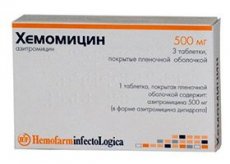Medical expert of the article
New publications
Preparations
Chemomycin
Last reviewed: 03.07.2025

All iLive content is medically reviewed or fact checked to ensure as much factual accuracy as possible.
We have strict sourcing guidelines and only link to reputable media sites, academic research institutions and, whenever possible, medically peer reviewed studies. Note that the numbers in parentheses ([1], [2], etc.) are clickable links to these studies.
If you feel that any of our content is inaccurate, out-of-date, or otherwise questionable, please select it and press Ctrl + Enter.

Indications Chemomycin
It is recommended to take this medicine during therapy (in combination with other medications) for the following diseases:
- Infectious diseases that affect the upper respiratory tract and other organs, including tonsillitis, sore throat, otitis media and sinusitis.
- Scarlet fever.
- Infectious diseases that affect the lower respiratory tract and other organs, including bronchitis, pneumonia.
- Infectious diseases that affect the urogenital organs, including cervicitis, urethritis.
- Infectious diseases of the skin and subcutaneous fat, including dermatosis, impetigo, erysipelas.
- Borreliosis, also known as Lyme disease, especially for patients in the early stages of the disease.
- Diseases that affect the duodenum and gastrointestinal tract, including diseases caused by Helicobacter pylori bacteria.
Release form
The manufacturer produces "Hemomycin" in three forms at once. In pharmacies, you can buy powder for suspensions, tablets or capsules. The powder is mainly used in the preparation of various suspensions (taken orally). It has a whitish tint and a pleasant fruity smell.
The capsules are light blue in color, gelatinous, and fairly hard. Inside is a white powder.
Film-coated tablets, convex on both sides, round, have a bluish tint.
Each of the above drugs contains the active ingredient azithromycin dihydrate.
 [ 3 ]
[ 3 ]
Pharmacodynamics
The antibiotic azithromycin is highly active. It belongs to the group of macrolides (azalide). If used in large doses, it is effective against many bacteria.
It can be used to combat gram-positive aerobic microorganisms (Streptococci - Streptococcus pyogenes, Streptococcus pneumoniae, Streptococcus spp., Streptococcus agalactiae, Staphylococcus aureus, Streptococcus viridans), gram-negative aerobic microorganisms (Moraxella (Moraxella catarrhalis), Influenza bacilli (Haemophilus influenzae), Bordetella (Bordetella parapertussis, Bordetella pertussis), Haemophilus ducreyi, Legionella (Legionella pneumophila), Campylobacter (Campylobacter jejuni), Helicobacter (Helicobacter pylori), Gardnerella (Gardnerella vaginalis), Neisseria (Neisseria gonorrhoeae)) and anaerobic microorganisms (Clostridium perfringens, Bacteroides bivius, Peptostreptococcus spp.), intracellular microorganisms (Ureaplasma urealyticum, Chlamydia trachomatis, Borrelia burgdorferi, Mycoplasma pneumoniae).
 [ 4 ]
[ 4 ]
Pharmacokinetics
Azithromycin is absorbed from the gastrointestinal tract quite quickly, as it is resistant to hydrochloric acid and lipophilic. If 500 mg of the drug is prescribed per 24 hours, the antibiotic can be detected in the plasma after 2.5 hours.
The distribution of the substance is also quite good, it quickly penetrates into the organs of the urogenital system, organs responsible for the respiratory function, various tissues, epithelium and the prostate gland. In tissues, the concentration of this antibiotic is always much higher than in the blood. A very important feature of this substance is that it can accumulate in large quantities in lysosomes. Its amount has sufficient bactericidal activity even five to seven days after taking a dose, so short courses can be carried out using Hemomycin.
This antibiotic is excreted through the kidneys.
Dosing and administration
The dosage of Hemomycin is standard: it is taken once every 24 hours (preferably before or after meals, since azithromycin may not work as effectively after meals).
In some cases (various diseases, patient's condition, intolerance to some drugs) the doctor may prescribe a different dosage. The powder-based suspension is created in accordance with the patient's body weight.
To properly prepare the suspension, gradually add boiled (but cooled to room temperature) water to the special mark in the bottle with the powder. Shake the mixture until a homogeneous whitish liquid is obtained. The suspension is stored only at room temperature for no more than five days. Shake before use. After use, wash down with water.
Use Chemomycin during pregnancy
For the treatment of pregnant women, Hemomycin is used extremely rarely and only after diagnosis and specialist prescription. If it is necessary to prescribe an antibiotic after the birth of a child, then during the period of therapy the woman stops breastfeeding the child.
Contraindications
Patients with liver and kidney failure, intolerance to this antibiotic are prohibited from using the drug. It cannot be used for therapy of children under six months (powder form) and under twelve months (all other forms).
Use with caution in patients with arrhythmia.
Overdose
In cases of overdose of Hemomycin, the following unpleasant symptoms may appear: nausea with vomiting, diarrhea, temporary hearing loss. For treatment, the stomach is washed and special means are used.
Interactions with other drugs
The use of antacids and Hemomycin together may reduce the absorption of the main component of the latter.
The effect of the antibiotic is significantly reduced by food or alcohol consumption.
When prescribing azithromycin with warfarin, it is necessary to monitor the prothrombin time in patients. If azithromycin and digoxin are used simultaneously, the amount of the latter in the body increases.
Symptoms such as dysesthesia and vasospasm may occur when Hemomycin interacts with dihydroergotamine and ergotamine.
Together with triazolam, azithromycin can enhance the effectiveness of the former and reduce clearance. When using Hemomycin with indirect anticoagulants, cycloserine, felodipine, methylprednisolone, carbamazepine and cyclosporine, the toxicity of the latter may increase.
Shelf life
The drug, released in capsules, can be stored for up to three years. All other forms of release - two years.
Attention!
To simplify the perception of information, this instruction for use of the drug "Chemomycin" translated and presented in a special form on the basis of the official instructions for medical use of the drug. Before use read the annotation that came directly to medicines.
Description provided for informational purposes and is not a guide to self-healing. The need for this drug, the purpose of the treatment regimen, methods and dose of the drug is determined solely by the attending physician. Self-medication is dangerous for your health.

